Amino group is o, p-directing for electrophilic substitution reaction. But, on nitration the major product is m-nitroaniline because
aniline gets protonated with strong acids to give anilinium ion which is m-directing
nitration requires nitric acid which oxidises NH2 to −NO2 group.
electrophilic NO+2 is a m-directing group
benzene ring exerts + I effect and deactivates the ring.
To solve the question regarding why the major product of nitration of aniline is m-nitroaniline, we can break down the reasoning into a series of steps:
Step 1: Understanding the Amino Group
The amino group (-NH2) is known to be an ortho-para directing group in electrophilic aromatic substitution reactions. This means that when a benzene ring with an amino group undergoes electrophilic substitution, the amino group typically directs incoming electrophiles to the ortho or para positions relative to itself.
Hint: Remember that ortho-para directing groups activate the ring for electrophilic substitution.
Step 2: Nitration Process
In nitration, we typically use a mixture of concentrated nitric acid (HNO3) and concentrated sulfuric acid (H2SO4) to generate the nitronium ion (NO2+), which is the electrophile that attacks the benzene ring.
Hint: Nitration involves generating a strong electrophile, the nitronium ion.
Step 3: Protonation of Aniline
However, in the presence of strong acids, aniline (C6H5NH2) can be protonated to form anilinium ion (C6H5NH3+). This protonation occurs because the amino group is basic and can accept a proton.
Hint: Strong acids can protonate the amino group, changing its directing effects.
Step 4: Directing Effect of Anilinium Ion
The anilinium ion (C6H5NH3+) is a weaker activating group compared to the neutral aniline. In this protonated form, the amino group behaves as a meta-directing group rather than ortho-para directing. Therefore, when nitration occurs on the anilinium ion, the nitronium ion will preferentially attack the meta position.
Hint: The protonated form of the amino group directs electrophiles to the meta position.
Step 5: Conclusion
As a result, the major product of the nitration of aniline is m-nitroaniline due to the formation of the anilinium ion, which directs the electrophilic attack to the meta position.
Final Answer: The major product is m-nitroaniline because the amino group gets protonated in strong acids to form anilinium ion, which is meta-directing.
Summary of Steps:
1. Recognize the ortho-para directing nature of the amino group.
2. Understand the nitration process and the generation of nitronium ion.
3. Acknowledge the protonation of aniline to form anilinium ion in strong acids.
4. Note the change in directing effect of the protonated amino group to meta.
5. Conclude that the major product is m-nitroaniline due to the meta directing nature of the anilinium ion.
The amino group (-NH2) is known to be an ortho-para directing group in electrophilic aromatic substitution reactions. This means that when a benzene ring with an amino group undergoes electrophilic substitution, the amino group typically directs incoming electrophiles to the ortho or para positions relative to itself.
In nitration, we typically use a mixture of concentrated nitric acid (HNO3) and concentrated sulfuric acid (H2SO4) to generate the nitronium ion (NO2+), which is the electrophile that attacks the benzene ring.
However, in the presence of strong acids, aniline (C6H5NH2) can be protonated to form anilinium ion (C6H5NH3+). This protonation occurs because the amino group is basic and can accept a proton.
The anilinium ion (C6H5NH3+) is a weaker activating group compared to the neutral aniline. In this protonated form, the amino group behaves as a meta-directing group rather than ortho-para directing. Therefore, when nitration occurs on the anilinium ion, the nitronium ion will preferentially attack the meta position.
As a result, the major product of the nitration of aniline is m-nitroaniline due to the formation of the anilinium ion, which directs the electrophilic attack to the meta position.
1. Recognize the ortho-para directing nature of the amino group.
2. Understand the nitration process and the generation of nitronium ion.
3. Acknowledge the protonation of aniline to form anilinium ion in strong acids.
4. Note the change in directing effect of the protonated amino group to meta.
5. Conclude that the major product is m-nitroaniline due to the meta directing nature of the anilinium ion.
Topper's Solved these Questions
- AMINES Book:NCERT FINGERTPS ENGLISHChapter:AMINES Exercise:Classification
Explore 2 Videos
- AMINES Book:NCERT FINGERTPS ENGLISHChapter:AMINES Exercise:Preparation Of Amines
Explore 5 Videos
- ALDEHYDES, KETONES AND CARBOXYLIC ACIDSBook:NCERT FINGERTPS ENGLISHChapter:ALDEHYDES, KETONES AND CARBOXYLIC ACIDSExercise:Assertion And Reason
Explore 15 Videos
- BIOMOLECULESBook:NCERT FINGERTPS ENGLISHChapter:BIOMOLECULESExercise:Assertion And Reason
Explore 15 Videos
Similar Questions
Knowledge Check
Alcohols are converted to tosylates by treatment with p-toluene sulfonyl chloride (TsCI) in the presence of pyridine. This overall process converts a poor leaving group (өOH) into good one (өOTs). A tosylate is a good leaving group because its conjugated acid p-toluene sulfonic acid is strong acid.
Because alkyl tosylates have good leaving groups, they undergo both nucleophilic substitution and β-elimination.

Find the major product of following reaction :
 A
A B
B C
C D
D
Alcohols are converted to tosylates by treatment with p-toluene sulfonyl chloride (TsCI) in the presence of pyridine. This overall process converts a poor leaving group (өOH) into good one (өOTs). A tosylate is a good leaving group because its conjugated acid p-toluene sulfonic acid is strong acid.
Because alkyl tosylates have good leaving groups, they undergo both nucleophilic substitution and β-elimination.

What would be the major product of following reactions ?
 A
A B
B C
C D
D
In an electrophilic aromatic substitution reaction, the nitro group is meta directing because of it?
View SolutionToluene o/p orienting with respect to an electrophilic substitution reaction due to
View SolutionIn an electrophilic substitution reactitution reaction of nitrobenzene, the presence of nitro group……
View SolutionAlthrough chlorine is an electron withdrawing group, yet it is ortho-para-directing in electrophilic aromatic substitution reactions. Explain why it is so ?
View SolutionNitration of aniline in strong acidic medium also gives m-nitroaniline because
View Solutiono,p-directing group are mostly :
View Solution
